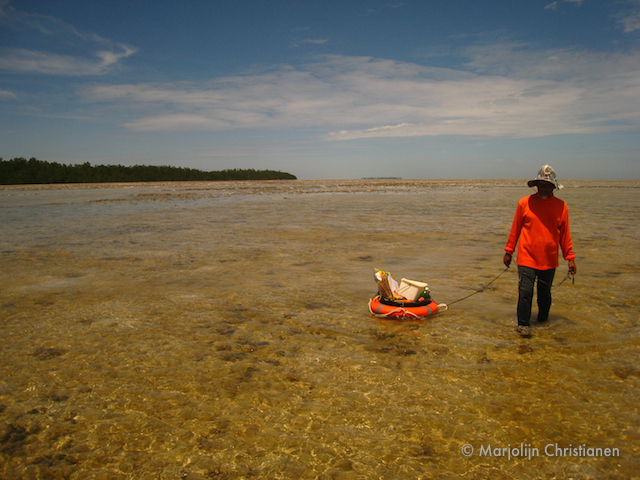Derawan did not changed a lot since I left 10 months ago. This time Wawan and me came for only a few weeks to do 3 experiments on Derawan Island and to go to the other important Green turtle foraging grounds on Maratua (40km from Derawan) and Pulau Panjang (8 km from D). What did we do?
Terimah kasih Wawan for some of the pictures!
In short: At Derawan island the turtles were still grazing the seagrass by digging out complete seagrass plants and we studied the regrowth of seagrass into the empty sand gaps. From the results from last year it was unclear what the effect of phosphate addition to the seagrass was, that is why we repeated the experiment from last year on small scale but now we added Phosphate (Calcium phosphate) in a different form to the seagrass. Thirdly I wanted to know if the consumption of seagrass by the green turtles changed between years so we monitored the surface area of empty sand gaps in permanent plots exactly 1 year after last measurements. And I estimated turtle density using line transects from a canoe. We repeated these measurements on the other important Green turtle foraging grounds on Maratua and Pulau Panjang. Life on Derawan Island was better than last year.
We found a very nice house to live, much cheaper (but more simple) than last year at pak Heru’s place. It was situated on poles above the seagrass and turtles. The temperature above the sea feels 10oC less than that between the houses on the island itself. We only had power from 18:00-6:00 and a fan but that didn’t matter because of the “natural air-conditioning” effect of the sea breeze/storms. And our rice warmer/dry oven, used to dry seagrass samples, could be replaced by the sun by placing the samples on our own jetty. There were 5 other rooms in the house but no guests so “Losmen Adhitya” felt like our own home. And Ibu Heldi really was an excellent cook, especially once you’ve seen here kitchen. Our neighbour is going to the mainland weekly to get some vegetables so at least for 6 days we had some, next to our rice and fresh fish. And for the rest power-food nasi goreng as breakfast. Ibu Heldi’s 7 year old son helped us sometimes with sorting the endless number of seagrass samples, a great place, Wawan and I really felt at home here!
During our stay there were 3 wedding parties on Derawan Island. This is a rather different party culture then I know from other cultures. And the only one I know were the couple isn’t the centre of attention but the music band is. Everybody arrived around 21:00, receiving a paper box with nasi goreng and water (which you take home to eat next day). Then you take place on a plastic chair, situated in rows so that everybody can see the band at the stage (somewhere in the corner the just married couple is sitting and staring). The dancers of the band are not what you expect in this muslim culture. Dressed in miniskirts, shaking their hips, I was completely shocked by there un-muslim performance, and so was Wawan. 1 hour later you can shake hands, take a picture and hand over your envelope with money and you can go home.
After finishing the last fieldwork I could finally visit LIPI Oceanography in Jakarta to present my research and thank professor Suharsono for al the permit letters. It was nice to have some discussions here and to see their interest in the special type of turtle grazing. After LIPI we visited “Seaworld” in Jakarta where Wawan made an appointment with Dodi (assistant Curator) and Wisnu (Veterinarian) to see Dugong (Dugong dugon =sea cow) “Diana” and the gigantic green turtles (Chelonia mydas). I was amazed to see that the green turtles only ate fish. Wisnu explained that when they try to feed them seagrass they ignore it and will start nibbling at each other so they stick to feed them fish. That is why they look so fat, not comparable to “our” turtles at Derawan Island! Dugong Diana is already 8 years old and 2,5m long and also a little bit to fat with her 170kg. So Wisnu put her on a diet. In staid of 22kg of seagrass (Syringodium isoetifolium each 2nd day harvested 40km away) they will lower it to 20 kg. I had plans to finally meet Tetha Hitipeuw (WWF sea turtles Indonesia) but while she was based in Bali she invited me to come over. In that way I could also join the workshop on turtle data and analysis collection in Denpasar before flying back to the Netherlands 2 days later. This was an excellent idea, I met a lot of interesting people and had chance to talk with Tetha about turtles, conservation problems at Derawan Island and a possible cooperation to study local turtle movements on foraging grounds. And it was the first time to join a presentation completely in Bahasa Indonesia so my brains were cooking but I learned a lot! So I could leave Indonesia very motivated! But before flying I had 1 day off, and so I had time to visit the Olive ridley turtle hatchery at Sarangan, get stuck in a burial ceremony on the streets, and to meet Suzette and Michiel (J !) who just arrived from the Netherlands for a holiday in Bali, Great to meet them here at the other side of the world! Together we went to the southern tip of Bali to see the last Sunset at the Uluwatu cliffs and the Reggeabar at Kuta just to watch the (quit shocking) beach toerists. A great last week, something different then being prisoned in my Derawan house, due too my balloon foot.
The 1st of November I will go back for 5 months, this time Sarah and Sjoerd from The Netherlands will join me as part of their MSc.

